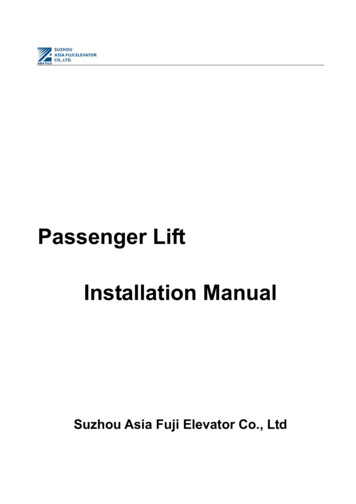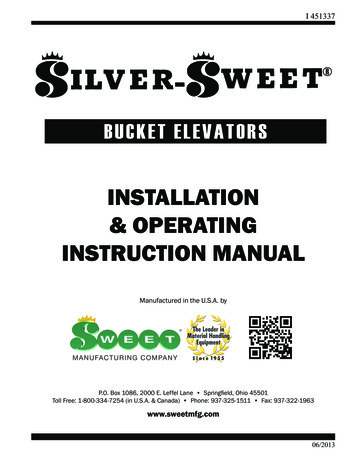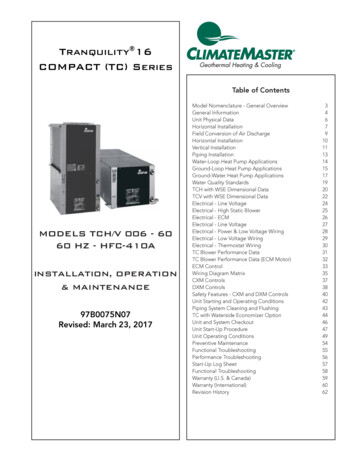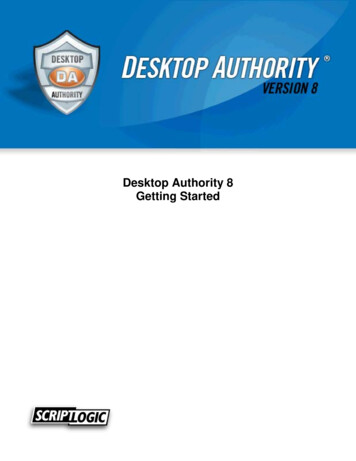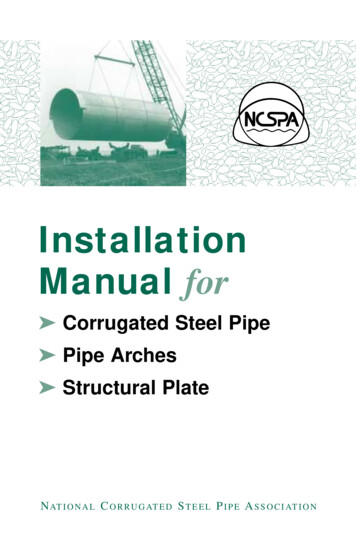
Transcription
InstallationManual for Corrugated Steel Pipe Pipe Arches Structural PlateN AT I O N A L C O R R U G AT E D S T E E L P I P E A S S O C I AT I O N
INSTALLATION MANUAL — NCSPAThe NCSPA Installation Manual is not a copyrighted publication.If excerpted or copied, credit to the source would be appreciated.* * *The information contained in this Installation Manual is theproduct of industry experience and practice. The methods usedto install corrugated steel pipe can affect both its effectivenessand useful life. The situations described in this publication andthe suggested techniques for installation are general suggestions and guidelines intended to alert installers to the need forcareful review of on-site conditions. Each installation willrequire its own individual evaluation. The statements ordescriptions provided herein are for general information only.The National Corrugated Steel Pipe Association assumes noresponsibility for their use.* * *08 InstallMan00N ATIONAL C ORRUGATED S TEEL P IPE A SSOCIATION1255 Twenty-Third Street, NW, Suite 200Washington, DC 20037-1174Phone: 202/452-1700 Fax: 202/833-3636E-mail: csp@ncspa.org Web: www.ncspa.org
CSP Installation Manual1TABLE OF CONTENTSFOREWORD . 3BASIC PRINCIPLES FOR PROPERCONSTRUCTION AND INSTALLATION . 4LOCATION . 5EXCAVATION. 5Embankment Condition. 5Trench Condition. 5Trench Width and Shape . 608 InstallMan00PREPARING FOUNDATIONS. 7Handling Poor Foundations. 7Uneven Foundations . 8Soft Foundations. 9Pockets of Unstable Soil . 9Swampy Foundations . 10Improved Foundations. 10Settlement Under High Fill Loads . 10Rock Foundations. 11Arch Foundations . 11ASSEMBLY. 12Unloading and Handling . 12Connecting Bands . 12Installing Connecting Bands . 12Typical Connecting Bands . 14Gaskets . 16Mastic . 17Asphalt Coated Pipe . 17Paved-Invert Pipe. 17Full Lined Pipe . 18Polymer Coated Pipe. 18Pipe Arch . 18Field Coated Structural Plate Structures . 18Structural Plate Structures. 18Tools Required . 19Erection . 19Long Span Structures . 21Lifting Assistance . 21End Treatment . 21Cut End. 22
National Corrugated Steel Pipe Association2ASSEMBLY (continued)Cut-Off Walls . 23End Sections . 24Other End Finishes . 24Stream Diversion . 24BACKFILLING . 25Backfill Material. 25Placing the Backfill . 25Pipe Arches. 30Arches. 30Large Diameter Structures . 32Proper Material Placement . 32Even Placement of Backfill. 33Shape Control . 33Multiple Installations. 34Long Span Structures . 35Final Backfilling. 35COMPACTION EQUIPMENT . 35Hand Compaction. 35Mechanical Compactors . 36Roller Compactors. 36Vibrating Compactors . 36Hydraulic Compaction . 36Structure Protection. 36Construction Loads . 37Hydraulic Protection . 38SUMMARY . 40SUBDRAINAGE . 41Underdrain Pipe. 41Flow Line . 41Preparing the Foundation . 41Assembly of Underdrain Pipe . 41Proper Placement of Underdrain Pipe. 42APPENDIX. 44Culvert Grades and Outfall Treatment . 44Length of Culverts. 44Skew Number . 47
CSP Installation Manual3FOREWORDThis manual is intended for both the contractor and the engineer. It providespractical information for the installation of corrugated steel pipe as stormsewers or culverts. It also provides the necessary considerations for properdesign to achieve long term performance of the culvert or storm sewer.Corrugated steel pipe with its high load carrying capacity, strong joints andexceptional beam strength is installed more easily than other types of conduit. However, the correct installation procedures must be followed to insurefull investment value in the structure.It is the intent of this manual to suggest ways and means of improvinginstallation practices. It is not intended to be used as a direct specification, but rather as a practical field guide for the installation of corrugated steel pipe, pipe arch and structural plate.Too much emphasis cannot be placed on the necessity of adequatecompaction of backfill. Faulty compaction has led to more trouble withpipe installations, flexible and rigid, than all other factors combined!OSHA safety regulations and guidelines must be observed during all phasesof construction including foundation preparation, excavation, pipe handling,assembly and backfilling.Additional information is available in the AISI Handbook of Steel Drainageand Highway Construction Products and ASTM Specifications A 798 andA 807.This manual uses dual units of measure with Imperial units shown first followed by metric units in parentheses. Complex drawings or tables may beduplicated in metric.
4National Corrugated Steel Pipe AssociationBASIC PRINCIPLES FOR PROPERCONSTRUCTION & INSTALLATIONProject plans and specifications provide the basic requirements for construction and installation. However, site conditions often vary from those anticipated during design. The contractor and construction engineer must recognize these variations. Often, alternate or additional construction considerations are necessary. The following guidelines provide specific considerationsand details for various conditions in a step-by-step construction sequence.The following summary will appear again near the end of the manual.However review it now as a basic outline of the steps required for a properinstallation:1) Check alignment in relation to the plans as well as theactual site conditions.2) Make certain the pipe length(s), necessary appurtenances,etc. are correct.3) Excavate to the correct width, line and grade.4) Provide a uniform, stable foundation—correct site conditions as necessary.5) Unload, handle and store the pipe correctly.6) Assemble the pipe properly—check alignment, follow special procedures for the connecting bands, gaskets, andother hardware used. (For structural plate structures,achieve properly aligned plate laps, bolt torque, andassembled dimensions.)7) Use a suitable (granular) backfill material as required inthe plans and specifications.8) Maintain proper backfill width.9) Haunch the pipe properly.10) Place and compact the backfill in 6 to 8 inches (150 to 200millimeters) of thickness of compacted lifts.11) Install the necessary end treatment quickly to protect thepipe and your efforts.12) Protect the structure from heavy construction equipmentloads, other heavy loads and hydraulic forces.
CSP Installation Manual5LOCATIONBefore installing any drainage structure, it is best to first recheck the plannedalignment and grade (position and percent of slope) of the pipe in relation tothe topography of the site. Even when complete construction plans are supplied, a careful examination of the site should be made.EXCAVATIONEmbankment ConditionThe only excavation typically required for an embankment condition is toremove the topsoil, muck and organic matter and prepare a stable foundationat the proper elevation and grade.Trench ConditionMost storm sewers are installed in trenches. Although pipes can be easilyinstalled in a trench, there are some general guidelines that should be followed.All trench excavation should proceed only after OSHA and other safetyrequirements are met. Trench excavation normally proceeds in the upgradedirection. Most trenching equipment is more efficiently operated in this manner, and pipe sections are also more easily joined when progressing in thisdirection. If excavated spoil is to be used as backfill, it should be stockpiledat a safe distance from the edge of the trench. As a general rule, when trenchwalls are unsupported, the distance from the trench edge to the toe of thestockpiled material should not be less than one-half the depth of the trench.When trench walls are protected by some form of sheeting or shoring, a safeminimum distance between the trench edge and stockpiled material must stillbe maintained, but will vary with soil and bracing types.Care should always be exercised in the operation of equipment in the vicinity of an open trench. Operated too close to the trench, equipment weight andvibration may collapse the trench walls. The three phases of construction ina trench (excavation, pipe installation, and backfilling) should be scheduledin close sequence with each other. An open trench is dangerous and vulnerable to accidents. An open excavation can result in damage to the projectunder construction. The two main hazards that must always be considered intrenching work are: Stability of trench walls; and Water that may accumulate in the trench resulting from seepage andsurface runoff.
6National Corrugated Steel Pipe AssociationTo minimize accidents and losses resulting from trenching operations the following procedures should be followed: Begin excavation only when installation of pipe can immediatelyfollow. Protect trench walls to insure their stability throughout the construction period. Follow procedures that will keep the trench free of seepage and surface waters. Excavate the trench at the same rate as pipe installation with a minimum distance, as dictated by safety, separating the two operations. Backfill the trench as soon as practicable after pipe installation.Trench Width and ShapeThe width and shape of the trench should be as shown on the plans. Anychange should be approved by the Engineer.Generally, the trench width will be specified as 12 to 48 inches (300 to 1200millimeters) wider than the pipe. However, it must be wide enough to allowthe critical lower quadrants of the pipe to be properly backfilled (haunched).Figure 16 provides guidelines about minimum spacing between multiplestructures. These same guidelines can be used to provide the necessary widthbetween the pipe and trench wall to adequately place typical backfill. Lesserspacing may be used with slurries and other backfill materials that do notrequire mechanical compaction.
CSP Installation Manual7PREPARING FOUNDATIONSFoundation requirements should be detailed on the plan sheets. However,field conditions often vary requiring special attention and alterations that arediscovered only during excavation. Any alterations should first be approvedby the Engineer.Although corrugated steel drainage structures can experience some unevensettlement without disjointing or breaking, they should be placed on a firm,uniform foundation for best performance and long service life.All storm sewers and culverts must be installed with the area under thehaunches well compacted and all voids filled.For corrugated steel pipe, the most popular method of preparing the foundation is by excavating to a flat surface and then carefully tamping the fill underthe haunches of the pipe. Proper backfill density can be achieved by compacting the soil with a wooden pole, 2 x 4, or the smaller sizes of pneumatictampers to eliminate all voids under the structure. See Figure 1 for typicalmethods of bedding corrugated steel structures and the 2 x 4 description.This “flat foundation” technique works well except for larger pipe-archesand horizontal ellipses. The vee-shaped bedding technique for these structures is shown in Figure 12.All pipe must be placed on stable earth or fine granular foundation. Neverinstall them on sod, frozen earth or on a bed that contains large boulders orrock. When poor foundations with low bearing strength are encountered,investigate the possibility of a change in pipe location. Otherwise, it may benecessary to stabilize the poor foundation by a method described in the nextsection.Care must be taken to prevent water leaking through the fill or along thepipe. When granular materials have been added for bedding, the ends of thefill should be sealed against infiltration. This can be done by bedding theends in well compacted clay or by adding some type of end treatment suchas an end section or a cut off wall.Handling Poor FoundationsIf poor or non-uniform foundations are encountered, they must be treatedcorrectly to assure satisfactory results. The critical factor is to achieve uniformity along the pipe with a tendency for the foundation to yield under thepipe in relation to alongside the pipe.
8National Corrugated Steel Pipe AssociationUneven FoundationsWhen the excavated grade line reveals both soft and hard spots, the foundation must be changed to make it as uniform as possible. Sometimes hardspots can be excavated below grade and replaced with softer material.Alternatively, it may be more economical to excavate the entire foundationslightly below grade line and replace it with suitable, uniform material. Inany event, any abrupt changes from hard to soft foundation must be avoided.Figure 1.Methods for attaining proper compaction under haunches of CSPand pipe-arch.*Note:When tamping with a 2 x 4, the designation of 2 x 4 will remain inusage as a descriptive expression without conversion to metric. Itrepresents an approximate lumber cross-section of 40 by 90 millimeters.
CSP Installation Manual9Treatment for Soft FoundationsDirection of desired relative movement shown by arrows.Figure 2.Soft FoundationsWhen soft, unstable material is encountered at the foundation level, it mustbe excavated below the flow line grade and backfilled to grade with sand,gravel, crushed stone or other suitable material. The zone of select materialmust be adequate to support the pipe and backfill. When unexpected materials are encountered, consult the Engineer.Pockets of Unstable SoilIf unstable foundation material is in small pockets, it is best to excavate allof the poor foundation and replace it with suitable backfill material.Frequently, a relatively thin mat of granular material will provide satisfactory support, but it may be necessary to replace very soft foundations to a depthgreat enough to support not only the pipe, but also the heavier backfill placedbeside it.
10National Corrugated Steel Pipe AssociationSwampy FoundationsCorrugated steel pipe must not be placed in direct contact with pipe bents orconcrete cradles that are installed to help provide a foundation. Such supports, if used, should be built with a flat top and covered with an earth cushion. In this way the flexible structure can develop side support without concentrating the load at any point.Improved Foundations(soft, uneven, unstable or swampy)Whenever a foundation is stabilized by using a coarse granular material, consideration of the bedding and backfill material becomes even more important. Fine materials can migrate into coarser materials and geotextile separators are often required to prevent this migration.Settlement Under High Fill Loads(camber for embankment installations)Cambering the center part of the foundation will compensate for unequal settlement under the weight of heavy embankments. This assures proper gradeafter settlement and prevents the structure from sagging in the middle as thefoundation consolidates. Generally, sufficient camber can be obtained byinstalling the upstream half of the pipe on a flat grade and the downstreamhalf on steeper than normal grade as shown in Figure 3. If camber is considered necessary based on foundation soil conditions, the amount of camberFigure 3.Correct method of cambering pipe to compensate for unequal settlement under high fills. Should be in accordance with procedure givenin the AISI Handbook of Steel Drainage and Highway ConstructionProducts.
CSP Installation Manual11must be determined by a qualified soils engineer. If the pipe is setting oncushioned rock or other adequate strength foundation, no camber is necessary, as settlement will be minor.Be careful not to raise the center of the pipe above the inlet, as this will pocket water in the pipe.Rock FoundationsRock encountered in the foundation must be removed to provide more thanthe minimum bedding thickness underneath the bottom of the structure.Excavate wide enough to avoid any possibility of the pipe resting on rock andprovide access to adequately haunch the pipe as shown in Figure 4. The excavated area is then backfilled with compacted, granular soil to cushion the pipe.Figure 4.Method of handling rock foundations. t 1/2 inch (13 millimeters) perfoot (.30 meter) of fill over pipe, with 24 inches (.60 meter) the maximum.Arch FoundationsArches differ from other structural plate structures in that they are generallyerected on concrete foundations. The key way or unbalanced channel inwhich the arch rests must be accurately built to the proper line, grade andspacing for easy assembly of the plates. The unbalanced channels must becarefully located to insure that the holes correctly align with those in theplates to permit bolting. They must be properly oriented (angled) to receivethe plate.
12National Corrugated Steel Pipe AssociationASSEMBLYUnloading and handlingPipe must never be dumped directly from a truck bed while unloading.Although corrugated steel drainage structures withstand normal handlingthey should be handled with reasonable care. Dragging the pipe at any timemay damage the coatings. Also avoid striking rocks or hard objects whenlowering pipe into trenches.Since corrugated steel pipes are relatively light weight, they can be handledwith light equipment. Use of slings is recommended to properly handle thepipe.Connecting BandsThe usual method of joining two or more lengths of pipe or pipe arch is bysteel connecting bands. The bands engage the ends of each pipe section. Theyare placed to overlap each pipe section equally. The corrugations on the bandmust fit into the corrugations of each pipe. Tightening of bolts draws theband tightly around the adjacent ends of pipe lengths, providing an integraland continuous structure.One piece bands are used for most installations of smaller sizes of pipe.“Two-piece” bands are used on larger diameter pipe and when installationconditions are difficult. “Rods and Lugs” are used on levees, aerial sewersand similar installations where bands that provide tighter and stronger jointsare essential.Typical bands, and their method of installation, are illustrated in Figures 4Ato 4E. Specially fabricated bolted, welded or riveted connectors can be supplied for use in jacking and for special or unusual conditions. If the pipe endshave been match marked by the fabricator, then they must be installed in theproper sequence.Installing Connecting BandsDuring the construction of a corrugated steel pipe system, care must be givento the assembly of joints to control both infiltration and exfiltration. Bothprocesses will have an effect upon backfill materials since soil particlemigration can occur. This is particularly true when fine “rained soils (finesands and silts) are present in the backfill material. When necessary, a gasket, a geotextile wrap, or both can also be used to control infiltration of fines.
13CSP Installation ManualBands are put into position at the end of one section of pipe with the bandopen to receive the next section. The next section is brought against or towithin 1 inch (25 millimeters) of the first section. After checking to see thatconnecting parts of both band and pipe sections match, that the interior ofbands and exterior of pipe are free of dirt, stones, etc., bolts are inserted andtightened.To speed the coupling operation, especially for large diameter structures, acinching device will help draw the band up tight. Special coupling devicescan be used to fit over the connecting bands and quickly draw them together. Advantage of these devices is that they permit faster hand-tightening ofthe bolts, so that a wrench is needed only for final tightening.On large diameter pipe and asphalt coated pipe, merely tightening bolts willnot assure a tight joint, due to the friction between the band and the pipeends. In such installation, tap the band with a mallet to take up the slack asthe band is tightened.The wrench used to tighten coupling bands may be a deep socket or ratchetwrench for greater speed.Band Angle ConnectorFigure 4A. Typical connecting band is wrapped around the joint and drawntogether.
14National Corrugated Steel Pipe AssociationStandard CouplersSemi-Corrugated (Hugger)Corrugated (Annular)FlatHat*Unless a dimple fillseach corrugationvalley, a suitablegasket or geotextilewrap is requiredUniversal*Gasketed CouplersSleeve GasketMastic or GasketCorrugated (Annular)HatO-RingSemi-Corrugated (Hugger)Figure 4B. Standard and Gasketed couplers for corrugated steel pipe.
CSP Installation ManualStandard CSP Band ConnectorsBand Angle ConnectorClip or Lug Angle ConnectorBar and Strap ConnectorFigure 4C. These typical band connectors are used with CSP couplingsystems.15
16National Corrugated Steel Pipe AssociationWhen required, connecting bands can be furnished with gaskets or mastic asfollows:GasketsClosed cell rubber, butyl rubber, neoprene, or closed cell rubber sponge gaskets are the basic types of materials to provide:(1) “O” ring gaskets which are recessed in a corrugation and then confined by the band after the joint is completed,(2) flat gaskets placed on each end of the pipe forming a joint and confined by the connecting band,(3) a flat sheet gasket placed over the ends of both pipes,(4) a gasket that is normally placed in the channel of the flanged bandconnector.For all field installed gaskets, a smooth round rod should be inserted underthe gasket and run around the circumference two or three times to equalizethe stretch in the gasket. On asphalt coated pipe it may be necessary to cleanthe gasket groove to properly seat the gasket. The alignment and assembly ofthe pipe sections is extremely important when gaskets are used. A lubricantmust be applied to the gasket for proper installation as recommended by themanufacturer. When a tightness test is required for final acceptance, the contractor should conduct his own test after a few joints are assembled as acheck of his assembly methods.O-Ring GasketSleeve GasketStrip Gasket orGeotextile WrapFigure 4D. Typical gaskets for use with connecting bands (where required).
CSP Installation Manual17MasticMastic may be applied to the connecting band or pipe prior to placing and tensioning the connecting band. A sufficient amount of mastic should be used tofill the joint space between the corrugation and band with some squeeze out.Asphalt Coated PipeAlthough asphalt coated corrugated pipe is laid and jointed in the same manner as galvanized pipe, special attention should be given to attaching the connecting bands. Contacting surfaces of the bands and pipe may need to belubricated. This allows the band to easily slip around the pipe so it can bedrawn more firmly into place. Lubrication is especially needed when surfaces are cold. In addition, tapping the bands with a mallet during tighteningwill help to assure proper joints.Paved-Invert PipePipe with an invert pavement must be stored and installed with the smooth,thick pavement in the bottom. Otherwise installation of paved-invert pipe isthe same as for galvanized corrugated steel pipe.If damage to the coating exposes the galvanizing, such areas must be patchedwith asphalt or bitumen before the structure is backfilled.Figure 5.Handling a section of large diameter pipe with sling.
18National Corrugated Steel Pipe AssociationFull Lined Pipe100% paved pipe is basically an extension of the paving in paved invert pipeto include the entire periphery. Since the paving covers all interior corrugations, the pipe should not be subjected to rough handling. Smooth steel linedpipe is fabricated with smooth steel liner suitably coated.When installations are to be made in hot weather, pipe lengths can be orderedwith an additional white coating on the pipe exterior to reduce the temperature of the pipe, if it is to be exposed to the bright summer sun for long periods. Prolonged storage of fully lined pipe should be avoided in any season.Polymer Coated PipePolymer coated pipe shall be installed in the same manner as asphalt coatedpipe. Lubrication is not required unless gaskets are used.Pipe ArchCorrugated steel pipe arch structures are installed in the same manner asround pipe. Recommendations regarding placement and connecting of various types of pipe also apply to pipe-arch. However, because of its shape, particular care should be taken in installing pipe arch structures. (See page 30.)Because of their multiple radius shape, pipe arches are not intended forrestrictive leakage or high cover applications.Field Coated Structural Plate StructuresField coated asphalt mastic coatings shall be applied per the manufacturer'sapplication instructions and material safety data sheet (MSDS).The coating shall be applied to a clean surface, free of dirt, oil, grease, orother foreign matter, when the atmospheric temperature is above 40 F (4 C).and the humidity is low enough that the surface of the metal can be kept dry.Coating may be applied by spray, brush, or trowel as required by the manufacturer to attain a uniform dry thickness of 0.05 inch ( 1.3 millimeters).Structural Plate StructuresTh
Additional information is available in the AISI Handbook of Steel Drainage and Highway Construction Products and ASTM Specifications A 798 and A 807. This manual uses dual units of measure with Imperial units shown first fol-lowed by metric units in parentheses





